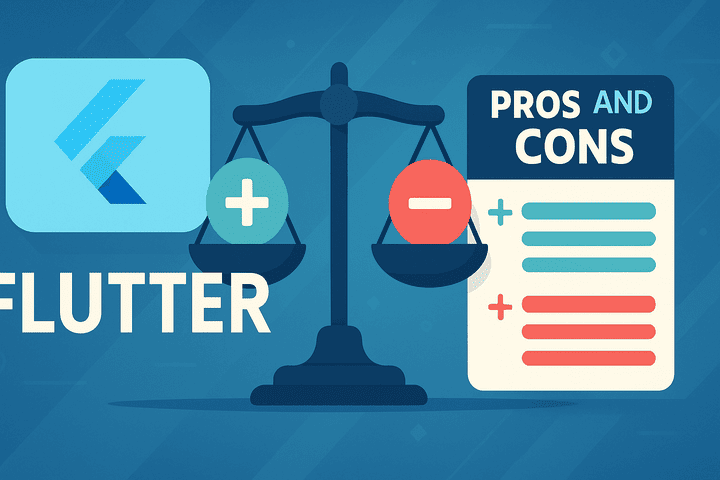Pros and Cons of Flutter

Table of Contents
Introduction
Flutter, Google’s open-source UI toolkit, enables developers to build natively compiled applications for mobile, web, desktop, and embedded devices from a single codebase. Its high performance, rapid development cycle, and rich widget library have driven widespread adoption. However, Flutter also introduces trade-offs in binary size, ecosystem maturity, and language adoption. This article dives deep into the pros and cons of using Flutter in 2025 to help you determine if it’s the right framework for your next project.
Pros of Flutter
Single Codebase Across All Platforms
Develop for Android, iOS, web, Windows, macOS, Linux, and embedded targets with one Dart codebase, reducing development and maintenance overhead.High Performance Rendering
Ahead-of-time (AOT) compilation of Dart to native ARM/x86 binaries, combined with the Skia/Impeller rendering engine, delivers smooth 60–120 FPS graphics without relying on platform UI components.Hot Reload & Hot Restart
Instantaneous code change propagation preserves application state, significantly accelerating development, debugging, and prototyping workflows.Rich, Customizable Widget Library
Built-in Material and Cupertino widgets provide pixel-perfect, adaptive UI components; full control over every pixel allows complex, custom designs.Powerful Tooling & DevTools
Theflutter doctorCLI, integrated DevTools (performance profiling, memory inspection, widget inspection), andflutter pubpackage management streamline setup, diagnostics, and optimization.Mature Package Ecosystem
Over 35,000 packages on pub.dev, with first-class support for Firebase, Google Maps, geolocation, and more.Stable Desktop & Web Support
Production-ready desktop channels for Windows, macOS, and Linux, and rapidly improving web support extend Flutter beyond mobile.Active Community & Google Backing
170k+ GitHub stars, regular stable releases, and an active contributor base ensure ongoing improvements and long-term viability.
Cons of Flutter
Larger Binary Sizes
Minimal release APKs start at ~4.7 MB; typical application builds without ABI splitting range from 10–15 MB, which can impact download times and storage on low-end devices.Dart Language Adoption
While Dart is easy to learn for many developers, its smaller talent pool compared to JavaScript or Kotlin may present hiring and training challenges.Platform API Bridging
Accessing novel or niche native SDK features requires writing and maintaining platform channels in Swift/Objective-C and Kotlin/Java.Web Performance & SEO Limitations
Flutter web apps often have larger payloads and slower initial load times than traditionally rendered SPA frameworks, and lack built-in SEO optimizations.Plugin Maturity Variance
Community-maintained plugins may lag behind official SDK updates or lack comprehensive documentation and maintenance.Memory & Resource Usage
Flutter apps generally consume more memory than native equivalents, which can affect performance on resource-constrained devices.Build & Compilation Overhead
Full rebuilds, shader compilation for Impeller, and large projects can lead to longer build and iteration times.
Use Cases
Graphics-Intensive Applications
Games, animation-rich interfaces, and custom UI experiences benefit from Flutter’s consistent 60–120 FPS rendering.Minimum Viable Products & Startups
Rapid iteration and a unified codebase minimize time-to-market and resource requirements for prototypes and early releases.Enterprise Cross-Platform Solutions
Consistent updates, controlled UI behavior, and strong testing tools make Flutter suitable for large-scale corporate applications.IoT & Embedded Systems
Flutter’s embedder API supports custom targets, enabling UI development on devices like Raspberry Pi and automotive infotainment.
Performance Optimization Tips
- Split per ABI
Generate separate APKs for each CPU architecture withflutter build apk --split-per-abito reduce download size. - Enable Tree Shaking
Remove unused Dart code and assets to shrink final binaries. - Minimize Overdraw
Use the Flutter Inspector to identify unnecessary widget repaints and streamline widget trees. - Proper Resource Management
Dispose of controllers, animation objects, and streams to prevent memory leaks. - Use Impeller on iOS
Opt into the Impeller rendering engine to precompile shaders and eliminate runtime shader compilation jank.
Conclusion
Flutter offers a compelling blend of performance, developer productivity, and cross-platform reach in 2025. Its strengths in UI consistency, hot reload, and ecosystem breadth make it an excellent choice for many projects. At the same time, larger binary sizes, the Dart learning curve, and platform-integration complexities warrant careful evaluation. By weighing these pros and cons against your team’s expertise and project requirements, you can determine whether Flutter aligns with your development goals.
Resources
- Official Flutter Site: flutter.dev
- Measuring Your App’s Size: docs.flutter.dev/perf/app-size
- Impeller Rendering Engine: docs.flutter.dev/perf/impeller
- Flutter Performance Best Practices: docs.flutter.dev/perf/best-practices
- Minimal APK Size Discussion: GitHub Issue #16833
- Flutter 3.29 Release Highlights: medium.com/flutter/3-29
- pub.dev Package Repository: pub.dev